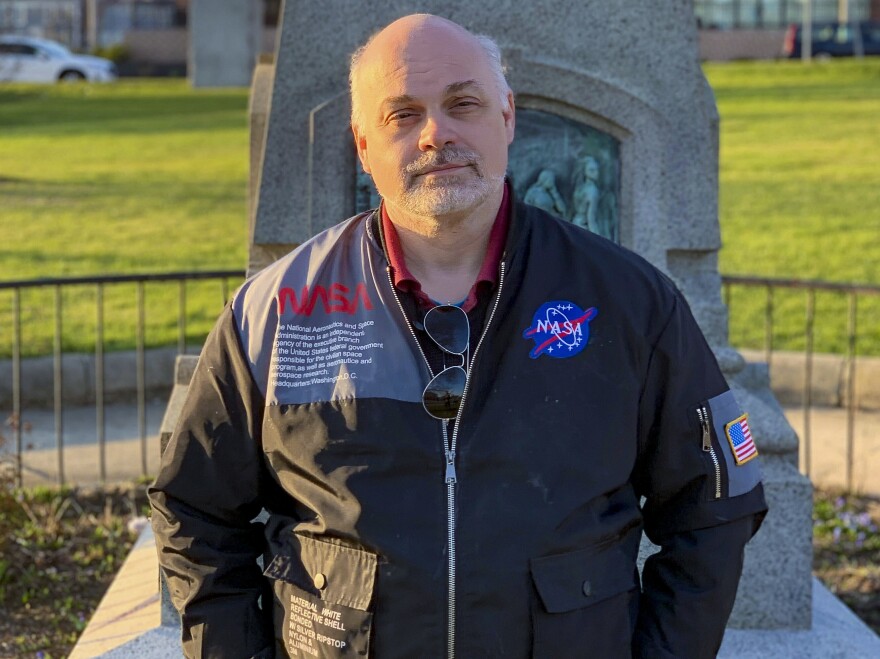A statue of a woman towers over a patch of daffodils in a city park in Haverhill, Mass. Scowling ferociously, she leans forward, gripping a hatchet.
The statue honors Hannah Duston, a 17th-century English colonist who is believed to have killed 10 Native Americans in order to escape captivity during King William's War. It has become a flashpoint in the country's ongoing debate about racist monuments, as locals reevaluate the Duston legend.
"That hatchet is supposedly the one that she actually used to, quote unquote, 'scalp the warriors,' " says Ron Peacetree of the Haverhill Historical Commission.
Peacetree explains how the popular legend — in which Duston acted in self-defense against a group of Native American warriors who had kidnapped her — is contradicted by historical evidence. A number of the scalps Duston later collected a bounty on, he says, belonged to children.
Scholars believe that's because by the time Duston made her escape, she was no longer traveling with her original captors but with a family group — likely Abenaki — who may have planned to ransom her back to her family, which was common practice at the time. The events unfolded in 1697, during one of the era's many conflicts between English and French colonists and their Native allies.
Peacetree says the monument, which was built nearly 200 years after Duston's capture, was propaganda to justify westward expansion.
"The propaganda story feeds into the white manifest destiny thing, feeds into the hatred against Native Americans," he says.
Growing up in the 1960s, Peacetree, who is half Haudenosaunee (commonly known as Iroquois), felt the consequences of this prejudice personally. He recalls the time his family was turned away from a hotel. "[The clerk] looked at my mom and us four kids and said, 'I'm sorry, we don't serve your kind here,' " Peacetree says. "This [statue] is the roots, part of the foundation of the philosophy that made that OK."

Last year, calls to remove the Haverhill statue ignited a fierce public debate. This month, the city decided to keep the statue but alter some of the offensive language on the base, remove the hatchet and provide space in the park for a Native American monument.
"I'm glad they left it where they left it," says 79-year-old Lou Fossarelli, who grew up in Haverhill and now lives in nearby Newburyport. "But I am not happy that the city is going to build a monument to the Indians. ... I know the history. There is no other version."
Meanwhile, an hour north of Haverhill in Boscawen, N.H., plans are already underway to rewrite the version of history most people know. There, the state's division of parks and recreation intends to redesign the site of another Duston monument.
Craig Richardson, a direct descendant of Duston who serves on an advisory committee for the project, believes a fuller story should be told. The committee is considering "changing the signage, changing the name of the park," he says, as well as adding a memorial to Duston's victims and information about Abenaki history.
"On one hand, as an Indigenous person, we don't want a statue that honors Hannah, but on the other hand, we need an outlet in order to share the true history of the region," says committee member Denise Pouliot, the lead female speaker for the Cowasuck Band of the Pennacook-Abenaki People. (A lead female and male speaker share leadership duties for the tribe.)
Though Pouliot finds the statue offensive, she believes it's her best opportunity to set the record straight.
"How many historical books have been written based on this false narrative that I can no longer wipe off the shelves?" she says.
In particular, Pouliot hopes to counter the version of the story popularized by the Puritan author Cotton Mather, in which Duston's captors brutally killed her newborn baby. It's a story scholars now doubt.

But Barbara Cutter, a professor of history at the University of Northern Iowa, argues that when considering what to do with the Duston statues, people shouldn't focus too much on what may or may not have happened in 1697.
"I think it's really more important to think about what people meant when they supported putting up this statue," she says. "And it wasn't about [Duston]. It was about an effort to hide the violence of colonization and imperialism."
How we should judge Hannah Duston is the wrong question, Cutter says. Instead, we should ask ourselves how we choose whom to memorialize and what stories we are trying to tell.
Copyright 2021 WBUR


